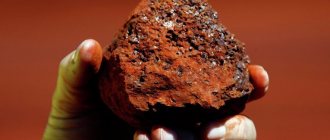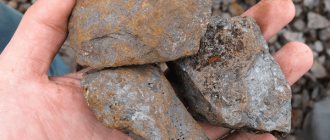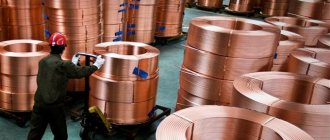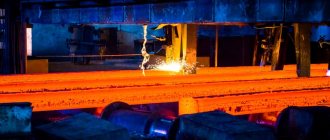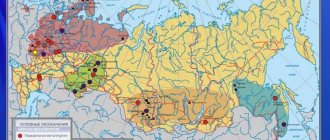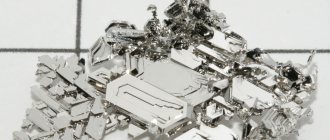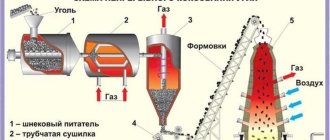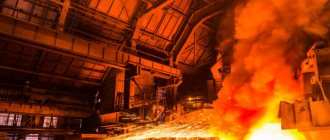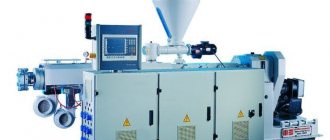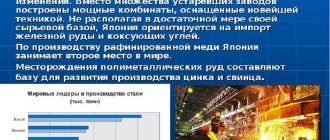Iron ore deposits in Russia
Iron ore resources are distributed unevenly across the territory of the Russian state. More than half of all reserves belong to Precambrian sedimentary ores. They are represented by red, brown, magnetic iron ores of varying quality. And only 12% of them are high quality ore, where the iron content is at least 60%. It is worth noting that the Russian state is second only to Brazil in iron ore reserves. But at the same time, domestic deposits, compared to foreign ones (Australia, India, Brazil), have lower quality ores and difficult geological conditions for their development.
Large iron ore deposits in Russia are located in the Central Federal District. It accounts for about 55% of all raw material production. There are quite significant deposits of proven reserves in Karelia and the Murmansk region, their production is 18%. The Gusevogorskoe deposit in the Sverdlovsk region produces almost 16% of iron ores. Development of the Kuranakh and Garinsky fields in the Amur Region, the Kimkansky and Kostenginsky fields in the Jewish Autonomous Okrug and others are also underway.
Rating of world countries by iron ore production for 2021
Ore mining is carried out on the territory of more than 50 countries. The industry leaders are China, Australia, Brazil, Russia, and India. Together they produce 80% of all iron-containing minerals.
Country rating
The volumes of the iron mining industry around the world are increasing from year to year, but they do not fully cover the needs of humanity. Many countries with developed mining and metallurgical industries lack their own iron ore resources and are forced to purchase it abroad.
The largest importers are South Korea, Japan, the USA, and EU countries. Even the Celestial Republic, which ranks 1st in the world in ore production, is forced to import it. Australia, Brazil and India export the most iron ore.
To imagine how the iron ore industry is developing, a comparative table of ore production per year (million tons) is presented:
| State | 2010 | 2016 |
| China | 900 | 1300 |
| Australia | 420 | 875 |
| Brazil | 370 | 391 |
| India | 160 | 260 |
| Russia | 100 | 100 |
| Ukraine | 72 | 80 |
| South Africa | 55 | 60 |
| Kazakhstan | 21 | 22 |
The Indian iron ore industry is witnessing steady growth. It is expected that by 2021 its indicators will increase by 35%.
Among all the mining companies in the world, 3 ore giants occupy a fundamental place:
- BHP Billiton, the largest Australian-British company.
- Vale SA (Brazilian company).
- Rio Tinto, a multinational corporation.
They conduct mining operations in many countries, own power plants, iron ore processing and steel smelting plants, carry out rail and sea transportation using their own transport, and set world prices for raw materials.
Kursk magnetic anomaly
Topping the list of iron ore deposits in Russia are the quarries of the Kursk Magnetic Anomaly (KMA). The area of its basin is more than 160 thousand km 2 and includes the territories of the Oryol, Belgorod, Kursk, and Voronezh regions. In terms of iron reserves, which amount to billions of tons, this is the largest basin in the world. To date, more than 30 billion tons of rich iron ore have been explored. Its bulk is represented by magnetite quartzites with an iron content of over 40%.
KMA ores are characterized by a multicomponent texture. Their depth varies from 30 to 650 meters. Industrial mining is mainly carried out in the Kursk and Belgorod regions, where a significant share of ore reserves are concentrated (Stoilenskoye, Mikhailovskoye, Lebedinskoye and Yakovlevskoye deposits).
What is iron ore and what does it look like?
Cuprous gold ores
Formations in the earth's crust containing iron in more or less pure form or its compounds with other substances: oxygen, sulfur, silicon, etc.
Such deposits are called ore when the extraction of a valuable substance on an industrial scale is economically profitable.
There are many types of such mineral formations. The species leader of the geological rock is red iron ore or hematite in Greek. The name translated from Greek means “blood-red” and has the chemical formula – Fe 2 O 3.
Iron oxide has a complex color ranging from black to cherry and red. Opaque, can be dusty and dense (in the second case it has a surface sheen).
Diverse in shape - found in the form of grains, scales, crystals and even a pink bud.
Bakcharskoye field
The Bakchar deposit is the most explored part of the West Siberian iron ore basin. It was discovered in the 1960s during exploration of oil deposits in the Tomsk region and today is one of the largest iron ore deposits in Russia. There are four ore layers on the territory, which in some places merge into a single deposit. Iron ore formations are mainly located at a depth of 190 meters, but to the north the dive reaches 300 meters. The iron content in the ores in some places reaches 57%. In enriched ore, the volume of iron increases significantly and reaches 97%. The area of the Bakcharskoye field is 16 thousand km 2.
A characteristic feature of the rich deposit is the presence of associated components of cobalt, titanium, chromium and vanadium, which further increases the value of the ores. According to preliminary estimates of geological research, the predicted reserves of the Bakcharskoye field are estimated at almost 110 billion tons. It should be noted that the ore horizons of this area are heavily watered and this causes difficulties in the exploitation of the deposit.
Extraction methods
The mining method is determined depending on the individual nature of the ore occurrence. The decisive factor, of course, is depth.
Open
As usual, if mineral resources are located not far from the surface of the earth (about 300 meters) and there is scope for carrying out a large amount of work to open and move soil, then they resort to creating a quarry. Powerful excavators move the rocks into dumps, and when they reach the lower layers of the deposits, they conduct a final analysis of the deposit for the percentage of iron content.
The final decision is made by the expert commission. In case of a positive result, the masses of seized rock are sent to metallurgical enterprises for further processing.
Closed
Although a significant amount of iron ore is mined by quarrying, sometimes it is necessary to resort to the construction of deep mines. This happens if the desired layers of minerals are located at a depth of about one kilometer. The process itself consists of laying a vertical shaft, from which horizontal drifts subsequently branch off.
Despite all its shortcomings (high cost of construction and danger of operation), this method is the most effective.
Also, in addition to these two methods, the method of borehole hydraulic extraction has recently found use. Its essence lies in the fact that water is supplied under significant pressure into the drilled well. As a result, the rock eroded by the jet moves upward.
Iron ore
Olenegorskoye field
The largest iron ore deposits in Russia include the Olenegorskoye deposit in the Murmansk region, which was discovered in 1932. Most of its raw material base is represented by ferruginous quartzites, the main minerals of which are magnetite and hematite. The presence of iron averages 31%. The ore lies almost to the surface, but the ore body goes to a depth of more than 800 meters with a length of 32 km. The ores of this deposit are easy to process; they have a minimal content of harmful impurities, which makes it possible to obtain high-quality metal.
Read also: Connecting LED strip wire cross-section
According to the latest estimates, the reserves of the Olenegorsk deposit on the Kola Peninsula amount to 700 million tons of iron ore. The presence of such significant reserves is contained in very deep horizons, which creates the need for additional subsoil exploration.
Kovdorskoye field
Due to its geological history, the Kola Peninsula has significant mineral deposits and makes a significant contribution to the Russian economy. The main iron ore deposits in this region began to be developed in 1962, although they were discovered before the war. The Kovdor iron ore deposit is one of the largest repositories of collectible raw materials in the state. Here are rare unique minerals that are not found anywhere else.
The Kovdor deposits have been developed since 1962; their reserves amount to about 650 million tons of magnetite ores. The width of the ore body is 100-800 meters, and the length stretches for more than a kilometer. Storeroom deposits have been explored to a depth of 800 meters. The average iron content is 28-30%. In addition to magnetite concentrate, baddeleyite and apatite concentrates are extracted from the ore.
Why is ore so important?
Man has learned to obtain various benefits from the earth for his existence since ancient times. Cultivation of the land allows him to grow food, and the extraction of minerals from its depths and their processing provide raw materials and fuel for a variety of purposes.
It was from the moment that man began to mine iron that a completely new stage began in his development. Today, life without metal can no longer be imagined - it has become so entrenched in all its spheres. Until the beginning of the twentieth century, the largest volume of metal ore mining was allocated to iron ore.
Despite the fact that iron is contained in many rocks, only the most economically viable ones are mined, which contain the largest amount of metals and are suitable for processing in terms of their qualities.
Kostomuksha field
Another important region where iron ore deposits are located in Russia is Karelia. There are 26 deposits and about 70 iron ore occurrences of various ore formations. Of more practical importance are the formations of ferruginous quartzites, which are well developed in the Western Karelian mineragenic zone. The palm belongs to the Kostomuksha deposit, which is considered the largest in North-West Russia. Its ore reserves amount to over one billion tons with an average iron content of 32%.
The thickness of the ferruginous quartzites of the Kostomuksha deposit stretches in a strip of 15.6 km. It includes two deposits at a depth of up to 40 meters - the main one and interbedded ones. The main deposit contains up to 70% of the field's total reserves. The dominant ore mineral is magnetite; harmful impurities include phosphorus and sulfur. The ores of the Kostomuksha deposit are easy to process.
Also, the following iron ore deposits should not be ignored: Korpangskoye (400 million tons of approved reserves), Pudozhgorskoye (forecast resources are estimated at 302 million tons) and Koykarskoye (reserves are estimated at almost 3,200 thousand tons).
The Republic of Khakassia
Khakassia is home to some of the oldest iron ore deposits in Russia. Its base is represented by the Teysko-Balyksinsky, Abakan-Anzassky and Verkhneabakansky districts.
Abagas ore deposits in the Kuznetsk Alatau area and the Minusinsk Basin were discovered in 1933, but their development began only 50 years later. The dominant mineral here is magnetite, secondary roles are given to pyrite, hematite and musketovite. Balance reserves of raw materials amount to more than 73 million tons.
The Abakan iron ore deposit is located near the city of Abaza. Its deposits are represented by easily enriched skarn-magnetite ores. Balance reserves contain 145 million tons of ore, the average volume of iron is 42-45%. The deposit has been explored to a depth of 1300 meters.
Kachkanar deposits
The group of iron ore deposits in the Sverdlovsk region has been known for quite a long time, but serious exploration began only in the 30s of the last century. It combines two main deposits: Gusevogorskoye and Kachkanarskoye. The deposits of ore minerals are represented by magnetite and contain mainly impurities of titanium and vanadium. They lie at great depths and have very complex development.
The Kachkanar deposits belong to the largest iron ore deposits in Russia, they account for 70% of the mined ores of the Urals. Predicted resources amount to more than 12 billion tons of ore, and proven reserves amount to 7 billion tons with an iron content of 16%. When ore is enriched, the volume of iron in the resulting concentrate reaches 61%.
Kerch basin
More recently, in connection with the annexation of Crimea, Russia’s wealth was replenished with the Kerch Basin, rich in iron ore. It is entirely located on the territory of the Kerch Peninsula of the Republic of Crimea, and has an area of more than 250 square meters. km. Total ore reserves are estimated at 1800 million tons. A peculiarity of ore deposits in this region is that they are located mainly in rock troughs.
Among the main deposits are Kyz-Aulskoye, Ocheret-Burunskoye, Katerlezskoye, Akmanayskoye, Eltigen-Ortelskoye, Novoselovskoye, Baksinskoye, Severnoye. Conventionally, all these deposits are united into the northern and southern groups.
Bakal deposits
The Bakal group of iron ore deposits is located in the Satka district of the Chelyabinsk region. It is concentrated on an area of 150 km2 and has 24 deposits, each of which has several ore bodies. There are two types of ores at the deposits: siderite (with an iron content of 32%) and brown iron ores (with an iron content of more than 50%). In explored and estimated reserves, the leading role is given to siderite ores. The main minerals of these deposits are pistomesite and sideroplesite.
Read also: GOST marking of electrical circuits
The following quarries are in operation at the Bakal ore field: Petlinsky, Central, Novobakalsky, Sosnovsky, Siderite, Shuldinsky. The total ore reserve is one billion tons. In terms of the quality of the ores and the amount of iron in them, the Bakalskoye deposit is one of the best iron ore deposits in Russia.
It should be noted that iron ore mining is one of the few segments of Russian industry that feels most confident even in a crisis. There are 173 iron ore deposits on the state balance sheet. Their balance reserves, at the current rate of production, will be able to provide ferrous metallurgy for more than 200 years in the future.
What is made from iron ore - uses of iron ore
The role of ferrous metallurgy in industry and economy
It is clear that iron ore is used to obtain metal. But two thousand years ago, metallurgists realized that in its pure form, iron is a rather soft material, products from which are slightly better than bronze. The result was the discovery of an alloy of iron and carbon - steel.
Carbon for steel plays the role of cement, strengthening the material. Typically, such an alloy contains from 0.1 to 2.14% carbon, and above 0.6% is already high-carbon steel.
Today, a huge list of products, equipment and machines are made from this metal. However, the invention of steel was associated with the development of gunsmithing, craftsmen in which tried to obtain a material with durable characteristics, but at the same time, with excellent flexibility, malleability, and other technical, physical and chemical characteristics. Today, high-quality metal also has other additives that alloy it, adding hardness and wear resistance.
The second material that is produced from iron ore is cast iron. It is also an alloy of iron and carbon, which contains more than 2.14%.
For a long time, cast iron was considered a useless material, which was obtained either when steel smelting technology was violated, or as a by-product metal settling at the bottom of smelting furnaces. It was mostly thrown away and cannot be forged (it is brittle and practically not ductile).
Before the advent of artillery, they tried to add cast iron to the household in various ways. For example, in construction, foundation blocks were made from it, coffins were made in India, and in China, initially, coins were even minted. The advent of cannons made it possible to use cast iron for casting cannonballs.
Today, cast iron is used in many industries, especially in mechanical engineering. This metal is also used to produce steel (open hearth furnaces and the Bessmer method).
Russian development that makes it possible to extract gold from coal
As production increases, more and more materials are required, which contributes to intensive mining. But developed countries consider it more expedient to import relatively inexpensive raw materials, reducing the volume of their own production. This allows the main exporting countries to increase the production of iron ore with its further enrichment and sale as concentrate.
Distribution of forecast resources of the Russian Federation for iron ore
In terms of the availability of predicted iron ore reserves, Russia ranks only third, behind Brazil and the United States. The total amount of ore in the Russian Federation is estimated at approximately 120.9 billion tons. If we consider the reliability of “intelligence data”, then the most accurately determined reserves (category P1) are 92.4 billion tons, the probability of full production is slightly less at 16.2 billion tons (category P2) and the lowest probability of extraction of explored ore is 2. 4 billion tons (category P3). The average iron content is 35.7%. The main part of the resources is concentrated on the KMA (Kursk Magnetic Anomaly), located in the European part of Russia. The deposits located in Siberia and the Far East are of less importance.
Deposits of the Urals
The Ural Mountains are also rich in iron ore. The main production area is the Kachkanar group of fields. Ore from this region has a relatively high titanium content. Mining is done by open-pit mining. The total explored volumes of iron ore are approximately 7000 million tons.
In addition, it should be said that the largest metallurgical plants in Russia are located in the Urals, in particular Magnitogorsk and NTMK. But at the same time, it should be noted that a significant part of the former reserves of iron ore has been exhausted, so they have to be imported to these enterprises from other regions of the country.
Distribution of ore reserves in Russia
The share of high-quality ore that does not require beneficiation, with an amount of iron of at least 60% in Russia, is almost 12.4%. Basically, the ores are medium and poor, with an iron content ranging from 16-40%. However, only Australia has large reserves of rich ores in the world. 72% of Russian reserves are classified as profitable.
Today there are 14 largest deposits in the Russian Federation. Of these, 6 are located in the Kursk anomaly area (i.e., more than half), which provides 88% of iron ore development. The State Balance Sheet of the Russian Federation has 198 deposits on its books, 19 of which have off-balance reserves. The main places of iron ore mining, located in descending order (according to the volume of mined minerals): – Mikhailovskoye deposit (in the Kursk region); – Gusevgorskoye metro station (in the Sverdlovsk region); – Lebedinskoye metro station (in the Belgorod region); – m. Stoilenskoye (in the Belgorod region); – m. Kostomuksha (Karelia); – m. Stoilo-Lebedinskoye (in the Belgorod region); – m. Kovdorskoe (in the Murmansk region); – m. Rudnogorskoye (in the Irkutsk region); – m. Korobkovskoye (in the Belgorod region); – Olenegorskoye metro station (in the Murmansk region); – m. Sheregeshevskoye (in the Kemerovo region); – Tashtagolskoye metro station (in the Kemerovo region); – m. Abakanskoe (Khakassia); – Yakovlevskoye metro station (in the Belgorod region).
Over the past decade, the Russian Federation has seen an increase in iron ore production. The average annual increase is about 4%. However, there is something to strive for: the share of Russian ore in global production is less than 5.6%. Basically all ore in Russia is mined at KMA (54.6%). In Karelia and the Murmansk region, the volume is 18% of the total production; in the Sverdlovsk region, 16% of ores are produced “for the mountain”.
World reserves
Fossils containing iron can be found on all continents. Deposits have been identified in 98 countries. Today, 212 billion tons of minerals are mined. Scientists suggest that the total mass of these rocks on the planet is 790 billion tons. The amount of iron in ore layers varies. There are rich, ordinary and poor deposits. Therefore, the ratio of the amount of mined ore and the iron obtained from it is different.
The quality of the vast majority of minerals is low. 86% of mined minerals contain from 16 to 40% iron. Therefore, raw materials need to be enriched with something. In Russia, 12% of high-quality material is mined, which contains more than 60% of the target raw materials. The highest quality minerals for the metallurgical industry are mined in Australia. The ore there contains 64% iron.
Minerals are mined if they contain enough raw material to make industrial processing feasible. There are three main types of products used in metallurgy:
- Separated.
- Agloruda.
- Pellets.
Rich deposits contain on average 57% iron, while poor deposits contain approximately 26%.
Classification of the breed according to morphological properties:
- Foundry.
- Flatbred.
Foundry rocks are wedge-shaped bodies located in areas of faults in the earth's crust. Such deposits contain a lot of iron from 54 to 69% with minimal amounts of sulfur and phosphorus.
Flat rock ore minerals are found at the upper levels of ferruginous quartzite beds. Enriched materials are processed in open hearth and converter furnaces, sometimes sent for direct reduction of target raw materials.
Main types of deposits:
- Layered sedimentary.
- Titanium magnetite.
- Skarn.
Less significant types of deposits:
- Siderite.
- Pasty lateritic.
- Carbolite and magnetite.
According to geological exploration data, the bowels of the earth contain approximately 80 billion tons of target raw materials worldwide. If ore is mined using modern methods in constant volumes, the duration of iron use is limited to 250 years.
